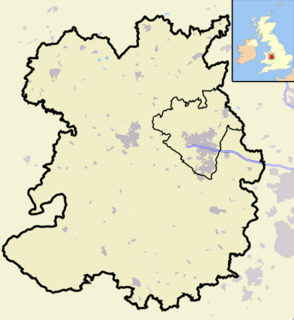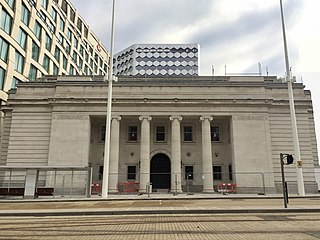Related Research Articles

Shropshire is a landlocked historic county in the West Midlands region of England. It is bordered by Wales to the west and the English counties of Cheshire to the north, Staffordshire to the east, Worcestershire to the southeast, and Herefordshire to the south. A unitary authority of the same name was created in 2009, taking over from the previous county council and five district councils, now governed by Shropshire Council. The borough of Telford and Wrekin has been a separate unitary authority since 1998, but remains part of the ceremonial county.
The Abbey National Building Society was formed in 1944 by the merger of the Abbey Road and the National building societies.

Yorkshire Bank is a trading name used by Clydesdale Bank plc for its retail banking operations in England.

Lloyds Bank plc is a British retail and commercial bank with branches across England and Wales. It has traditionally been considered one of the "Big Four" clearing banks. Lloyds Bank is the largest retail bank in Britain, and has an extensive network of branches and ATMs in England and Wales and offers 24-hour telephone and online banking services. As of 2012 it had 16 million personal customers and small business accounts.

The Trustee Savings Bank (TSB) was a British financial institution. Trustee savings banks originated to accept savings deposits from those with moderate means. Their shares were not traded on the stock market but, unlike with mutually held building societies, depositors had no voting rights; nor did they have the power to direct the financial and managerial goals of the organisation. Directors were appointed as trustees on a voluntary basis. The first trustee savings bank was established by Reverend Henry Duncan of Ruthwell in Dumfriesshire for his poorest parishioners in 1810, with its sole purpose being to serve the local people in the community. Between 1970 and 1985, the various trustee savings banks in the United Kingdom were amalgamated into a single institution named TSB Group plc, which was floated on the London Stock Exchange. In 1995, the TSB merged with Lloyds Bank to form Lloyds TSB, at that point the largest bank in the UK by market share and the second-largest by market capitalisation.

The Shropshire Wildlife Trust is a wildlife trust covering the geographic county of Shropshire, England.

Permanent TSB Group Holdings plc, formerly Irish Life and Permanent plc is a provider of personal financial services in Ireland.
Shropshire was established during the division of Saxon Mercia into shires in the 10th century. It is first mentioned in 1006. After the Norman Conquest it experienced significant development, following the granting of the principal estates of the county to eminent Normans, such as Roger De Montgomery and his son Robert de Bellême.
TSB Bank Ltd trading as TSB, is a New Zealand bank with headquarters in New Plymouth. It has 25 branches across the country but is heavily focused on the Taranaki region where 12 of its branches are located.
Shropshire's Geology is very diverse and most geological periods of time, and most rock types, can be found within the county. There is also a large amount of mineral wealth in the county, including lead, barytes, limestone, coal and iron, which helped the area develop the industrial revolution west of Clee Hill and, later, in the Ironbridge Gorge area. Quarrying is still active, with limestone for cement manufacture and concrete aggregate, sandstone, greywacke and dolerite for road aggregate, and sand and gravel for aggregate and drainage filters. Groundwater is an equally important economic resource.

The Birmingham Municipal Bank was a savings bank in the city of Birmingham, England. It was created as the Birmingham Corporation Savings Bank by a 1916 Act of Parliament on a temporary basis and replaced by the Birmingham Municipal Bank in 1919. In 1976 it converted into a trustee savings bank.
Formed in 1836, the Edinburgh Savings Bank was successor to the Edinburgh Bank for Savings, which dated back to 1814. Although formed after the Ruthwell Savings Bank, the Edinburgh provided the model for future savings banks. By the end of World War two, it was second in size only to the Glasgow Savings Bank. In 1975, Edinburgh merged with three other Scottish savings banks to form an enlarged South of Scotland TSB.
The Aberdeen Savings Bank is a Scottish savings bank. It was formed in 1815 and reconstituted in 1845 under the 1835 Savings Act. It remained a small bank until the interwar period when a series of acquisitions made it grow to fifth in size in 1944. It became one of Scotland's four regional savings banks in 1975. In 1983, it became a part of TSB Scotland.
The Glasgow Savings Bank, formed in 1836, had become the largest savings banks in Scotland by the mid-1850s and the largest in the country by 1870. When the trustee savings banks were reorganised into regional banks in 1975 Glasgow became the core of the West of Scotland TSB.
The Stockport Savings Bank was formed in 1824 in Stockport, then in the county of Cheshire. It was run on a conservative basis but remained independent until 1975 when it became part of TSB North West Central, following the Page Committee’s recommendation that the TSBs be grouped into larger regional entities.
The Sheffield Savings Bank was formed in Sheffield Yorkshire in 1819. For much of its early years it was run conservatively, briefly experimenting with local branches in the 1850s. In the twentieth century, branches were reintroduced, both in the City and outlying towns. By 1944 it was twelfth nationally by size of funds. In 1976, the Bank merged to form part of TSB Yorkshire & Lincoln.
The Perth Savings Bank was established in Perth, Scotland, in 1815. In 1975, it merged to form part of the Trustee Savings Bank of Tayside and Central Scotland.
The Liverpool Savings Bank was a bank founded in 1815 in Liverpool, United Kingdom. By 1956, it had grown to be the fourth largest savings bank in the country. Following the 1975 TSB Act, the Bank became part of the TSB of Mid-Lancashire & Merseyside.
The Manchester and Salford Savings Bank opened in 1818 in Manchester. For a long period, it was the third largest savings bank in the country and at one stage, the largest savings bank in England. Following the Trustee Savings Bank Act of 1975, the Bank merged with seven other local savings banks to form the TSB North West Central.
The London Savings Bank was a product of a 1916 merger between the London Provident Institution (1816), the Bloomsbury Savings Bank (1817) and the Lambeth Savings Bank (1818). In 1942 the Finsbury and City of London Savings Bank amalgamated with the London Savings Bank. In 1971, the London Savings Bank became part of the London and South Eastern TSB, which in turn became part of TSB South East.
References
- 1 2 3 4 5 Albert Harrison, West Midland Trustee Savings Bank 1816-1966, Shrewsbury, 1966
- ↑ "West Midlands Trustee Savings Bank records". Archives Hub. Retrieved 28 December 2021.
- ↑ "Welshpool Savings Bank records". Archives Hub. Retrieved 28 December 2021.